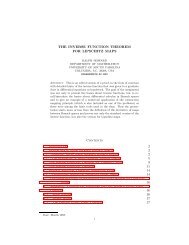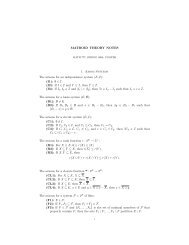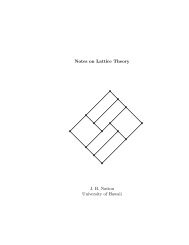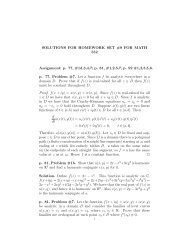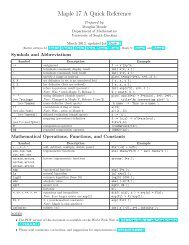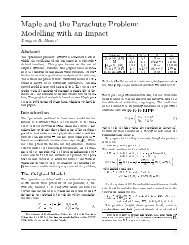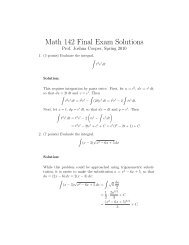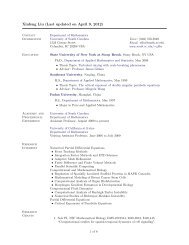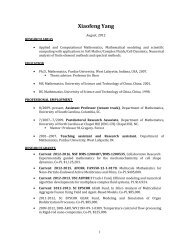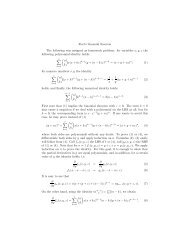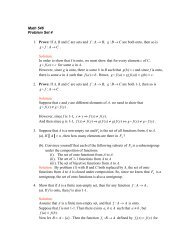Solutions
Solutions
Solutions
You also want an ePaper? Increase the reach of your titles
YUMPU automatically turns print PDFs into web optimized ePapers that Google loves.
Problem Set 4<br />
MATH 778P, Fall 2008, Cooper<br />
Expiration: Wednesday, December 10<br />
You are awarded up to 15 points for each problem, 5 points for submitting<br />
solutions in L ATEX, and 5 points per solution that is used for the answer key.<br />
1. Let G = (V, E) be the graph whose vertices are all 7 n vectors of length n<br />
over Z7, in which two vertices are adjacent iff they differ in precisely one<br />
coordinate. Let U ⊂ V be a set of 7 n−1 vertices of G, and let W be the<br />
set of all vertices of G whose distance from U exceeds (c + 2) √ n, where<br />
c > 0 is a constant. Prove that |W | ≤ 7 n e −c2 /2 .<br />
Solution (Mark Walters): Fix c > 0 and define ɛ = e −c2 /2 . Consider<br />
{0, 1, 2, 3, 4, 5, 6} n as the underlying probability space, where all points are<br />
equally likely. For y ∈ {0, 1, 2, 3, 4, 5, 6} n set<br />
X(y) = min ρ(x, y)<br />
x∈U<br />
where ρ is defined to be the Hamming metric on {0, 1, 2, 3, 4, 5, 6} n . Let<br />
X0, X1, . . . , Xn = X be the martingale given by exposing one coordinate<br />
of {0, 1, 2, 3, 4, 5, 6} n at a time. The Lipschitz condition holds for X: If<br />
y, y ′ differ in just one coordinate then |X(y) − X(y ′ )| ≤ 1. Thus, with<br />
µ = E[X], Azuma’s inequality yields<br />
But<br />
so µ ≤ 2 √ n. Thus<br />
and<br />
Pr[X < µ − 2 √ n] < e −22 /2 1<br />
= ,<br />
e2 Pr[X > µ + c √ n] < e −c2 /2 = ɛ.<br />
Pr[X = 0] = |U|7 −n = 1<br />
7<br />
Pr[X > (c + 2) √ n] < ɛ<br />
1<br />
> ,<br />
e2 |B(U, (c + 2) √ n)| = 7 n Pr[X ≤ (c + 2) √ n] ≥ 7 n (1 − ɛ).<br />
It follows that |W | ≤ 7 n − 7 n (1 − ɛ) = 7 n ɛ.<br />
1
2. Let σ be a random permutation of [n], and fix a permutation τ of [k]. Recall<br />
that, for a set I ∈ � � [n]<br />
k , we say that “the pattern τ occurs in σ on I” if σ|I<br />
is order-isomorphic to τ. Denote by Xτ (σ) the number of sets I ∈ � � [n]<br />
k<br />
for which τ occurs in σ on I. Show that<br />
��<br />
���<br />
Pr X τ (σ) − 1<br />
k! ·<br />
� �� � �� �<br />
n ��� 2 n<br />
−(1 + o(1))ɛ n<br />
≥ ɛ < exp<br />
k k<br />
2k4 �<br />
.<br />
Solution (Aaron Dutle):<br />
Note that E[Xτ (σ)] = 1<br />
� � n<br />
k! k<br />
Consider the function Xτ (σ) and the martingale given by at step i revealing<br />
the location of the number i in σ. Note that given two partially<br />
revealed permutations, the next revealed number could on one extreme<br />
be completely unusable in finding τ in σ, or on the other, be usable as<br />
any of the k symbols of τ and with any choice of k − 1 elements from the<br />
remaining n − 1. Thus our martingale satisfies<br />
� �<br />
n − 1<br />
|Xi+1 − Xi| ≤ k<br />
k − 1<br />
So if we define a new martingale Y by Yi = Xi<br />
k( n−1 then the martingale<br />
k−1)<br />
Y0, Y1, . . . Yn is actually Lipschitz. Set µ = E[Y ] = Y0, and Y = Yn.<br />
Now we note that<br />
��<br />
���<br />
Pr Xτ (σ) − 1<br />
� �� � ��<br />
n ��� n<br />
≥ ɛ<br />
k! k k<br />
��<br />
����<br />
Xτ (σ)<br />
= Pr<br />
k � � �<br />
1 n<br />
k! k � n−1 −<br />
k−1 k � �<br />
� � � n<br />
� k � n−1 � ≥ ɛ<br />
�<br />
k−1 k � �<br />
� n−1<br />
k−1<br />
�<br />
= Pr |Y − µ| ≥ ɛ n<br />
k2 �<br />
�<br />
= Pr<br />
by Azuma’s inequality.<br />
Noting that<br />
�<br />
2 exp − ɛ2n 2k4 �<br />
|Y − µ| ≥ ɛ√ n<br />
k 2<br />
� �<br />
√<br />
n < 2 exp − ɛ2n 2k4 �<br />
�<br />
= exp ln(2) − ɛ2n 2k4 � � �<br />
= exp − 1 − 2k4 ln(2)<br />
ɛ2 � 2 ɛ n<br />
n 2k4 �<br />
and that k is fixed, this is<br />
� 2 −(1 + o(1))ɛ n<br />
exp<br />
2k4 �<br />
,<br />
the desired bound.
3. Show that, with high probability, G(n, 1/2) contains a path of length n(1/2+<br />
o(1)).<br />
Solution (Wei-Tian Li): Here we apply the Theorem 8.5.1. Set p =<br />
[(log n)/n]ω(n), where ω(n) → ∞ arbitrary slowly. Then in G(n, p) almost<br />
always deg(x) ∼ (n − 1)p for all vertices x. Let ω(n) = n/2 log n,<br />
then p = 1<br />
n<br />
2 and hence δ(G) > 2 with high probability. By the fact that if<br />
δ(G) > k, then there exists a path of length k in G, so with high probability<br />
G(n, 1/2) contains a path of length n(1/2 + o(1)).<br />
4. Prove that, for every ɛ > 0 there is some n0 = n0(ɛ) so that for every n > n0,<br />
there is a graph on n vertices containing every graph on k ≤ (2 − ɛ) log 2 n<br />
vertices as an induced subgraph.<br />
Solution (Xing Peng): Here, we want to use the general form of Janson’s<br />
inequality. The statement is following.<br />
Let I be the index set and {Bi}i∈I be a collection of events. Set XBi<br />
be the indicator variable of Bi and X = X . Set ∼ be the dependence<br />
i∈IBi<br />
graph. If µ = E[X], ∆ = �<br />
�<br />
Pr[Bi ∧ Bj] and δ = max Pr[Bj]. Then<br />
Pr[ �<br />
i∈I<br />
i∼j<br />
i<br />
i∼j<br />
Bi] ≤ exp(−min{ µ2 µ µ<br />
, ,<br />
8∆ 2 6δ }).<br />
For any natural number n, take a graph G(n, 1<br />
2 ). For a fixed graph H<br />
on k = (2 − ɛ) log2 n vertices, Let the index set be � � [n]<br />
k and BS be the<br />
event that H is isomorphic to the subgraph induced by some vertex set<br />
S ∈ � � [n]<br />
k . Then<br />
Pr[BS] = 1<br />
� � n<br />
k , µ =<br />
2) 2) ,<br />
and<br />
∆ =<br />
� � k−1<br />
n �<br />
k<br />
i=2<br />
� n−k<br />
k−i<br />
2 (k<br />
�� k<br />
i<br />
�<br />
2 2(k 2)−( i , δ =<br />
2)<br />
2 (k<br />
k−1 �<br />
i=2<br />
� n−k<br />
k−i<br />
Then 8∆<br />
µ 2 = 8 �k−1 i=2 g(i), where g(i) is defined in Section 4.5. By the proof<br />
of Theorem 4.5.1, we have 8∆<br />
µ 2 < k<br />
µ2 n<br />
n and then 8∆ > k . Simply estimation,<br />
µ n<br />
2 > k , here we need k = (2 − ɛ) log2 n and we can not omit ɛ. Moreover,<br />
µ n<br />
6δ > k . Hence,<br />
Pr[ �<br />
Bs] ≤ e −n/k .<br />
S∈( [n]<br />
k )<br />
For this H, let AH be the event that H is not a induced subgraph of<br />
G(n, 1<br />
2 ) and An be the event that there is some graph on k vertices which<br />
is not a induced subgraph of G(n, 1<br />
2 ). Then<br />
Pr[AH] < e −n/k .<br />
2 (k<br />
�� k<br />
i<br />
2)<br />
�<br />
.
and<br />
Pr[An] < 2 (k2)<br />
−n/k k<br />
e < 2 2 /2 −n/k k −n/k 1<br />
e < n e <<br />
nα Here, α > 1 and n sufficiently large.<br />
The Borel-Cantelli Lemma applies, alway all An fail for n sufficiently large.<br />
Thus, there is some n0 so that for every n > n0, there is a graph on n<br />
vertices containing every graph on k vertices as an induced subgraph.<br />
5. Find a threshold function for the property: G(n, p) contains at least n/6<br />
pairwise vertex disjoint triangles.<br />
Solution (Aaron Dutle):<br />
Claim that r(n) = n −2/3 is a threshold function for G(n, p) to contain n/6<br />
vertex disjoint triangles.<br />
Suppose that p(n) ≪ n −2/3 .<br />
If H is the graph made of n/6 vertex disjoint triangles, note that for a<br />
particular choice of the of 3-sets of vertices of the triangles, the probability<br />
that H occurs with these as the triangles in G(n, p) is p n/2 , since n/2 is<br />
the number of edges of H.<br />
If we consider making this choice by choosing three vertices for the first<br />
triangle, then choosing three for the second, then the third, etc. until we<br />
have n/6 of them, noting that there are then (n/6)! ways that we can<br />
choose the same set, we see there are<br />
� � n<br />
3,3,...,3,n/2<br />
(n/6)!<br />
such possible choices. So if X denotes the number of times H occurs in<br />
the graph, the expectation of X is<br />
E[X] =<br />
� n �<br />
3,3,...,3,n/2<br />
(n/6)!<br />
p n/2<br />
Rewriting this in an equivalent form, and then estimating using � �<br />
n n<br />
e <<br />
n! < nn we have<br />
E[X] =<br />
≤<br />
n!<br />
6n/6 � � � �<br />
n n p<br />
2 ! 6 ! n/2<br />
n n<br />
6n/6 � �<br />
n n/2 � � p<br />
n n/6<br />
2e 6e<br />
n/2<br />
= n n/3 2 n/2 e 2n/3 p n/2
Since p ≪ n−2/3 , eventually p <<br />
is<br />
< n n/3 2 n/2 e 2n/3<br />
�<br />
1<br />
8e4/3n2/3 1<br />
8e 4/3 n 2/3 after which the quantity above<br />
� n/2<br />
= 2 −n = o(1)<br />
Hence X = 0 almost surely, proving one direction of the threshold function.<br />
For the opposite direction, suppose that p(n) ≫ n −2/3 . To make the proof<br />
go easier, note that if p(n) > ln(n)n −2/3 we can randomly remove edges<br />
from our G(n, p) to reduce to the case p(n) = ln(n)n −2/3 . So we can<br />
assume that p(n) ≤ ln(n)n −2/3 .<br />
Consider a subset of the vertices of G(n, p) of size n/2. For each set of<br />
three vertices in this set, we let Bi be the event that the three vertices are<br />
a triangle. The expected number of triangles is then<br />
� �<br />
n/2<br />
µ = E[X] = p<br />
3<br />
3<br />
We’re going to use Janson’s inequality, so we compute ∆ = �<br />
i∼j Pr[Bi ∧<br />
Bj]. We choose a triangle, choose an edge of it, and choose a third vertex<br />
to count all of the i ∼ j. The probability of each of these is p 5 , giving<br />
� �<br />
n/2<br />
∆ = 3(n/2 − 3)p<br />
3<br />
5 .<br />
When applying Janson’s inequality, we get Pr �� �<br />
−µ+∆/2<br />
Bi < e<br />
Since this is the probability that a single choice of n/2 of the vertices<br />
contains no triangle, and the probability for any other choice of an n/2<br />
subset would be the same, conclude that � � �� � n<br />
n/2 Pr Bi is the number of<br />
n/2 subsets of the vertices that have no triangle. Estimating this, we find<br />
<<br />
� �<br />
n<br />
�� �<br />
Pr Bi<br />
n/2<br />
� �n/2 ne<br />
e<br />
n/2<br />
−µ+∆/2<br />
< e n e −µ+∆/2 = e n−µ+∆/2<br />
We want this quantity to go to 0 as n → ∞, so we need that the exponent<br />
is going to −∞.<br />
Since we know p < ln(n)n −2/3 , we can approximate<br />
n − µ + ∆/2
� �<br />
n/2<br />
= n − p<br />
3<br />
3 � �<br />
n/2<br />
+ 3(n/2 − 3)p<br />
3<br />
5<br />
< n − n3<br />
216e 3 p3 + n4<br />
64 p5<br />
≤ n − n3<br />
10 4 p3 + (ln(n))5<br />
n 1/3<br />
Since p ≫ n −2/3 , eventually p > 10 5/3 n −2/3 , so this quantity is<br />
which clearly goes to −∞.<br />
Thus � � �� � n<br />
n/2 Pr Bi = o(1).<br />
< n − 10n + (ln(n))5<br />
n 1/3<br />
= −9n + (ln(n))5<br />
n 1/3<br />
So with high probability every n/2 sized subset of G(n, p) has a triangle.<br />
To find n/6 vertex disjoint triangles, we take them greedily, choosing an<br />
n/2 sized subset, taking its triangle, choosing another n/2 subset avoiding<br />
our chosen triangle, and so on. With high probability, we only run out of<br />
n/2 subsets to choose when our triangles use n/2 of the vertices, which is<br />
when we have n/6 triangles chosen.<br />
Thus n −2/3 is a threshold function for G(n, p) having n/6 vertex disjoint<br />
triangles.<br />
6. Let G = (V, E) be a graph with chromatic number χ(G) = 1000. Let<br />
U ⊂ V be a random subset of V chosen uniformly among all 2 |V | subsets<br />
of V . Let H = G[U] be the induced subgraph of G on U. Prove that<br />
Pr[χ(H) ≤ 400] < 1<br />
100 .<br />
Solution (Yiting Yang): Let L(U) be the chromatic number of G[U].<br />
Let X0, X1, . . . , Xm be the martingale on L by exposing a color class each<br />
time. Xm(U) = L(U).<br />
Let U and U ′ be two subsets of V which differ only in one color class. Then<br />
|L(U ′ ) − L(U)| ≤ 1, which implies L satisfied the Lipschitz Condition. By<br />
Theorem 7.4.2, we have<br />
where µ = E[L].<br />
P r[L < µ − λ √ m] < e −λ2 /2 ,<br />
Recalling E[L] ≥ 500 in Homework 2, we have
P r[L[U] < 400] = P r[L[U] < 500 − √ 10 √ 1000]<br />
≤ P r[L[U] < µ − √ 10 √ m] < e −(√ 10) 2 /2<br />
= e −5 < 1<br />
100 .<br />
7. Show that there exists a binary string S of length at most c2n log n/n so<br />
that, for every w ∈ {0, 1} n , there is a length n subword of S identical to<br />
w except in at most one coordinate. (We say that w1w2 · · · wk−1wk is a<br />
subword of S1S2 · · · SN−1SN if there is some j so that Sj+i = wi for all<br />
1 ≤ i ≤ k.) Hint: Take a random string. How many w’s are missed? Tack<br />
them onto the end of the string.<br />
Solution (Mark Walters): Let w ∈ {0, 1} n and randomly select a<br />
string S of length 2n log n<br />
n . Let Ai be the event that the length n subword<br />
beginning at the ith coordinate of S is identical to w except in at most<br />
one coordinate. Note that<br />
Pr[Ai] =<br />
n + 1<br />
2 n<br />
because there are n choices for the “free” coordinate and of course one<br />
additional subword that didn’t require a “free” coordinate. Also, note<br />
that<br />
µ = �<br />
Pr[Ai] = (|S| − n + 1)<br />
i∈I<br />
n + 1<br />
2 n<br />
where I = {1, 2, . . . , |S| − n + 1}. Now, in the event that Ai and Aj are<br />
dependent events for i < j, we need to assess the amount of overlap, i.e.,<br />
the value of j − i, in order to calculate ∆. It’s obvious that the smallest<br />
overlap is 1 while the largest overlap is n − 1. If j − i = k then we get<br />
Pr[Ai ∧ Aj] ≤ n2 + k 2 + (2n − 1)(1 − k)<br />
2 2n−k<br />
because there are 2n − k coordinates involved and we have to allow that<br />
at least one of them is a “free” coordinate. So, we get<br />
∆ = �<br />
Pr[Ai ∧ Aj] =<br />
i∼j<br />
|S|−n+1 �<br />
|S|<br />
i=1<br />
i=1<br />
k=1<br />
n−1 �<br />
2<br />
k=1<br />
Pr[Ai ∧ Aj]<br />
� n−1 � n<br />
≤ 2<br />
2 + k2 + (2n − 1)(1 − k)<br />
22n−k |S|<br />
�<br />
<<br />
i=1<br />
�<br />
2 k<br />
2 −2n+2 n 3<br />
n−1<br />
k=1
|S|<br />
�<br />
= 2 −2n+2 n 3 (2 n − 1)<br />
i=1<br />
|S|<br />
�<br />
< 2 −n+2 n 3<br />
i=1<br />
= |S|2 −n+2 n 3<br />
Now plugging into The Janson Inequality we get<br />
� �<br />
�<br />
Pr ≤ exp � − (|S| − n + 1) n2 −n+1 + � |S|2 −n+2� /2 �<br />
i∈I<br />
Ai<br />
= exp � (−|S|n + n 2 − n)2 −n+1 + |S|2 −n+1�<br />
= exp � |S|2 −n+1 (1 − n) + (n 2 − n)2 −n+1�<br />
� n 2 log n<br />
= exp<br />
n<br />
�<br />
2 log n<br />
= exp<br />
n − 2 log n + n2 − n<br />
2n−1 �<br />
−2 log n<br />
→ e<br />
= n −2<br />
2 −n+1 (1 − n) + (n 2 − n)2 −n+1<br />
In other words, given a word w ∈ {0, 1} n , the probability that there does<br />
not exist a length n subword of S identical to w except in at most one<br />
coordinate is at most n −2 . Since there are 2 n possible words w ∈ {0, 1} n ,<br />
we need to tack on 2 n n −2 words of length n. In other words, we need to<br />
tack on 2n<br />
n many coordinates to S to form a new string ¯ S, which has fewer<br />
than 2 2n log n<br />
n<br />
coordinates. Since we are not even doubling the size of S,<br />
the size of ¯ S is c2 n log n/n and now for each w ∈ {0, 1} n there exists a<br />
length n subword of ¯ S identical to w except in at most one coordinate.<br />
8. Let G = G(n, p) with p = [(3 log n)/n2 ] 1/3 . Show that, with high probability,<br />
every pair of vertices in G is connected by a path of length 3. (Note<br />
that a path of length three has four vertices.)<br />
Solution (Bill Kay): First, we calculate the probability that a given<br />
pair of vertices has a path of length 3 between them. If � � n<br />
2 is o(P r[a<br />
given pair of vertices do not have a path of length 3) , we can apply the<br />
union bound. Pick two vertices at random, call them x0 and x3. For<br />
counting purposes, it is convenient to think of this path as going from<br />
x0, x1, x2, x3. Now, there are n − 2 ways to pick x1 and then n − 3<br />
ways to pick x2. Also, each of the edges has to be in the graph. If X<br />
is the random variable that counts the number of paths between x0 and<br />
x3, E[X] = µ = (n − 2)(n − 3)p3 . To calculate ∆, simply notice that two<br />
paths can only intersect in one place; If they intersect in the edge between<br />
x1, x2 then the other edges are fixed. We first count the number of ways<br />
�
two paths could intersect in the edge (x0, x1), and by symmetry we get<br />
how many ways two paths could intersect in the edge (x2, x3). First, there<br />
are n − 2 ways to choose the common (x1). Then, there are � � n−3<br />
2 ways<br />
to pick the middle edges. The last two edges are now fixed. Each edge<br />
has to be in, so the calculation gives ∆ = 2(n − 2) � � n−3 5<br />
2 p . We now apply<br />
Jansen’s inequality. The probability that none of the paths are in the<br />
graph is bounded above by e −(n−2)(n−3)p3 +(n−2)( n−3<br />
2 )p 5<br />
. Plugging in the<br />
proposed value for p, a little work gives:<br />
e −(n−2)(n−3)p3 +(n−2)( n−3<br />
2 )p 5<br />
= e −(n−2)(n−3)([(3 log n)/n2 ] 1/3 ) 3 +(n−2)( n−3<br />
2 )([(3 log n)/n 2 ] 1/3 ) 5<br />
≤ e −n2 ([(3 log n)/n 2 ])+n 3 ([(3 log n)/n 2 ] 5/3 )<br />
= e<br />
3 log n<br />
−3 log n+ 1<br />
n 3<br />
−3 log n+o(1)<br />
= e<br />
Clearly, � � n − log n<br />
2 = o(e ), so the union bound can be applied as desired.



